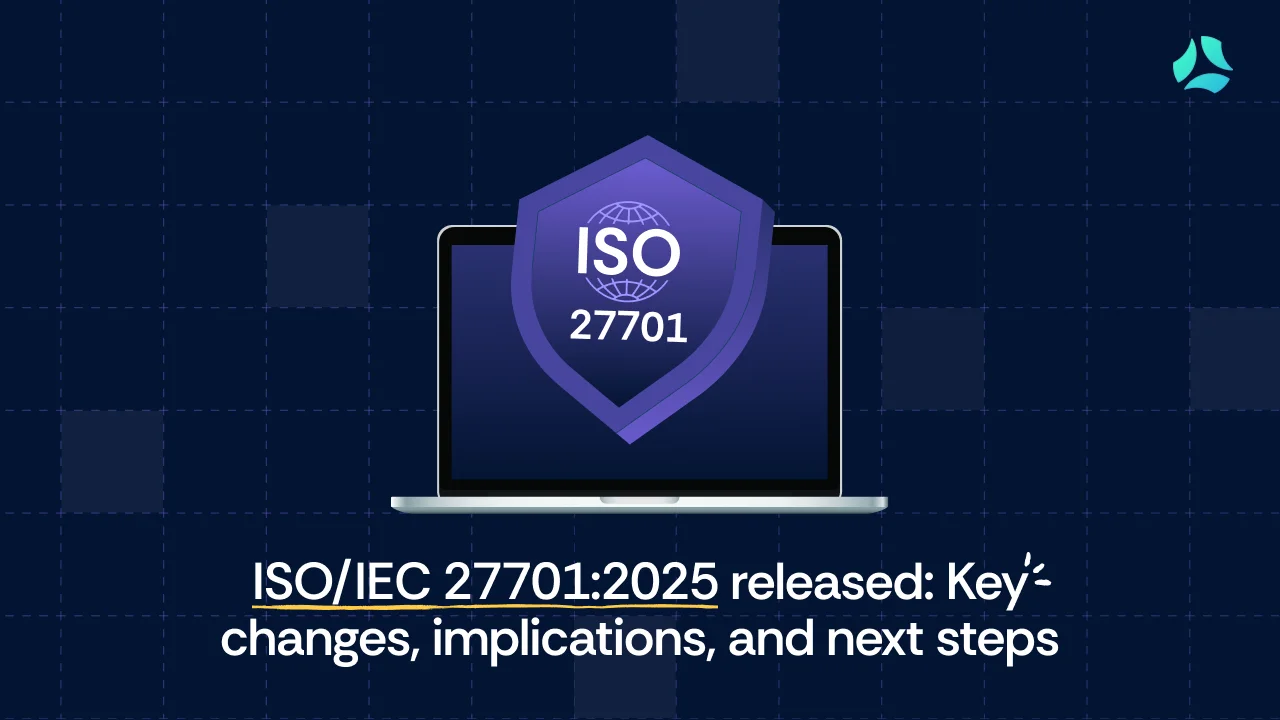Risk Avoidance vs Risk Reduction
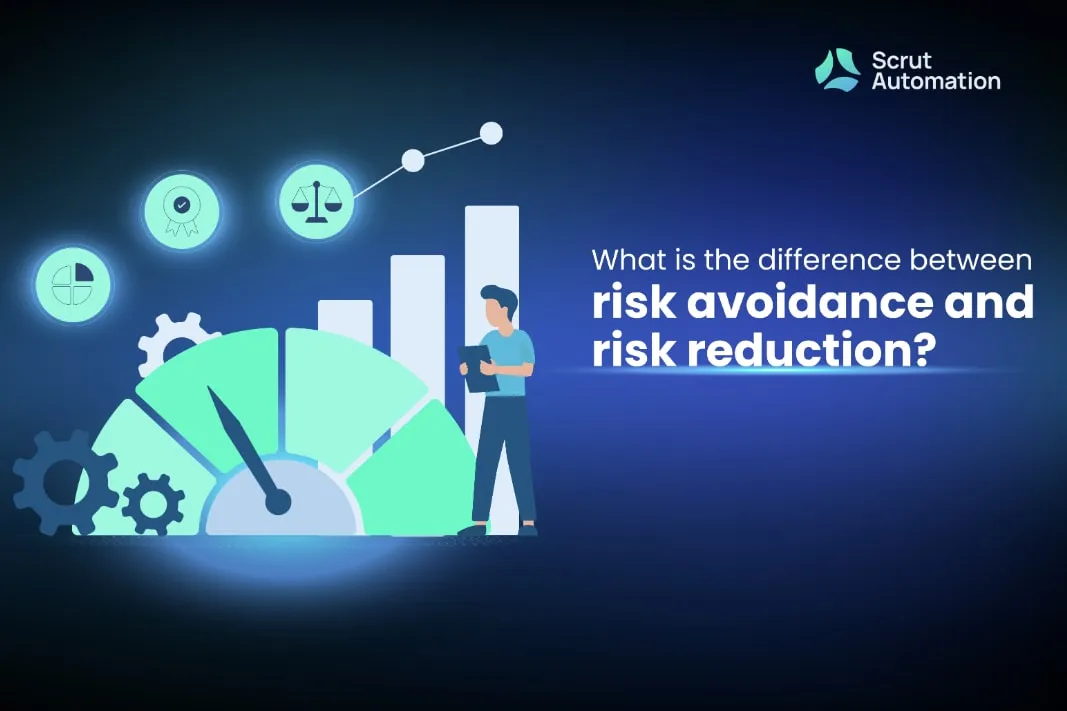
Often used interchangeably, risk avoidance and risk reduction are very different concepts. Although both are approaches to the risk management process in general, they have different roles to fulfill in the overall risk management of the organization.
First things first, what is risk management? Well, cyber risk management involves identifying, assessing, and mitigating threats to an organization’s digital assets and data security. It aims to safeguard against cyberattacks and data breaches.
Effective risk management involves the process of identifying, assessing, and prioritizing risks to minimize their potential negative impact while maximizing opportunities.
The importance of risk management cannot be overstated, as it helps individuals and organizations make informed choices, achieve their objectives, and safeguard their assets. Organizations even manage risk registers to keep track of their risk management processes.
In this article, we will learn about the two approaches to risk management—risk avoidance and risk reduction—and how they differ from each other.
Risk avoidance: Understanding the concept
Let us start with the first approach to risk management – risk avoidance.
What is risk avoidance?
Risk avoidance is a risk management strategy that involves completely steering clear of activities, decisions, or situations that could lead to adverse consequences. It is a deliberate choice to eliminate exposure to a particular risk by avoiding any actions or circumstances that might give rise to it. The underlying principle of risk avoidance is to ensure that the risk does not materialize, thereby preventing potential harm or losses.
Risk avoidance is typically chosen when the potential consequences of a risk are deemed unacceptable, and the preferred course of action is to completely eliminate the risk rather than attempt to mitigate it.
Examples of risk avoidance strategies
a. Network segmentation
Dividing a network into isolated segments to prevent lateral movement by attackers. By limiting access between segments, the risk of unauthorized access to critical systems is avoided.
b. Software whitelisting
Allowing only approved and trusted applications to run on a system, preventing the execution of potentially harmful or unauthorized software, thus avoiding the risk of malware infections.
c. Data backup and recovery
Regularly backing up data and systems to avoid data loss due to cyberattacks or system failures. This approach avoids the risk of data loss and downtime.
d. Employee training
Providing comprehensive cybersecurity training to employees to reduce the risk of insider threats and human errors, ultimately avoiding security breaches.
e. Regulatory compliance
Ensuring strict adherence to industry-specific regulations and compliance standards to avoid legal and financial penalties related to non-compliance.
f. Hardware disposal
Properly disposing of outdated hardware by securely wiping data or physically destroying storage devices to prevent data breaches through discarded equipment.
Advantages of risk avoidance
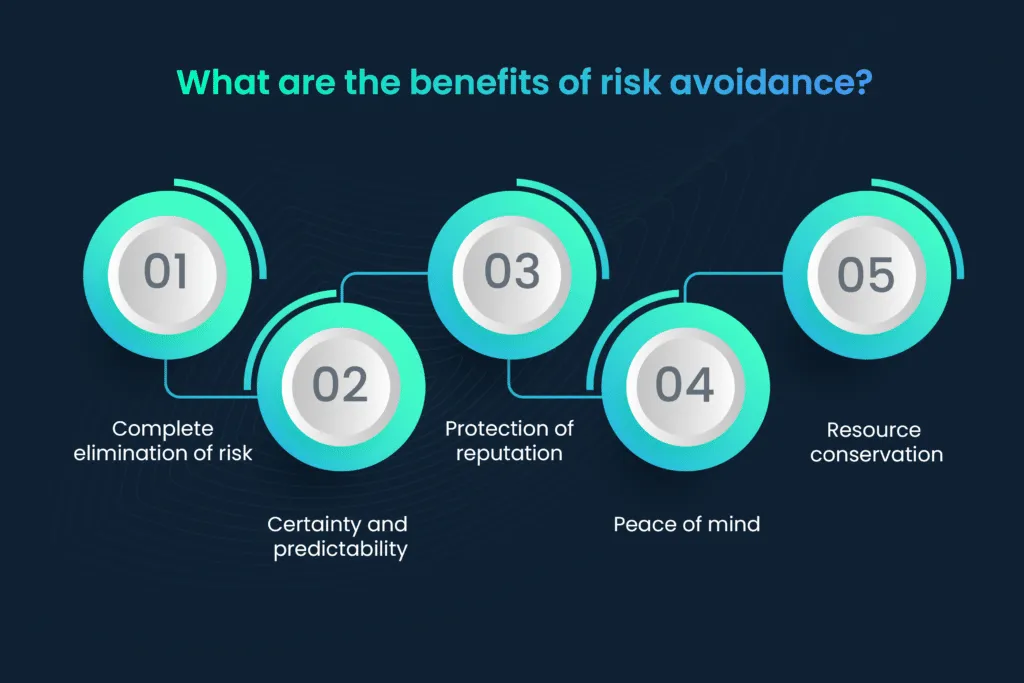
The following are the advantages of risk avoidance:
a. Complete elimination of risk
The most significant advantage of risk avoidance is that it completely eliminates the risk in question. By avoiding the activity or decision associated with the risk, individuals or organizations can prevent potential harm, losses, or adverse consequences.
b. Certainty and predictability
Risk avoidance provides a high degree of certainty and predictability because it eliminates the uncertainty associated with risky endeavors. This can be particularly appealing in situations where the potential consequences are severe or unpredictable.
c. Protection of reputation
Avoiding high-risk situations can protect an individual’s or organization’s reputation. Not being associated with failures or crises resulting from risky activities can help maintain a positive image.
d. Peace of mind
Knowing that a risk has been completely eliminated can provide peace of mind to decision-makers. This can reduce stress and anxiety associated with the potential negative outcomes of risky actions.
e. Resource conservation
Risk avoidance can conserve resources that would otherwise be allocated to manage or mitigate the risk. This can lead to cost savings in terms of time, money, and effort.
Limitations of risk avoidance

Risk avoidance may also come with limitations, such as missed opportunities or higher costs associated with safer but less rewarding choices.
a. Missed opportunities
Perhaps the most significant drawback of risk avoidance is the potential for missed opportunities. By avoiding all high-risk situations, individuals or organizations may forgo potentially lucrative ventures or innovations.
b. Reduced innovation and growth
Risk avoidance can stifle innovation and hinder growth. Avoiding all risks may lead to stagnation and prevent individuals or organizations from achieving their full potential.
c. Higher costs
In some cases, risk avoidance can be more costly than risk management or mitigation. For example, opting for the safest but most expensive option may lead to increased expenses without a commensurate increase in benefits.
d. Limited learning and experience
Avoiding risks means missing out on valuable learning experiences. Over time, this can lead to a lack of adaptability and resilience in the face of adversity.
e. Competitive disadvantage
In highly competitive industries, risk avoidance can put individuals or organizations at a disadvantage. Competitors who are willing to take calculated risks may gain a competitive edge and market share.
f. Inefficiency
Overzealous risk avoidance can lead to inefficiencies. For example, excessive bureaucracy or stringent regulations aimed at eliminating risks can hinder productivity and innovation.
The decision to employ risk avoidance should be carefully weighed against the specific circumstances, risk tolerance, and long-term objectives of individuals or organizations to strike the right balance between risk mitigation and potential rewards.
Risk reduction: A closer look
Let us now talk about the second approach to risk management – risk reduction. It is not solely about avoiding risks but rather about optimizing the balance between potential rewards and potential downsides. It acknowledges that risks are inherent in any endeavor and seeks to empower individuals and organizations to make informed decisions that align with their objectives while minimizing exposure to undesirable outcomes.
What is risk reduction?
Risk reduction is a fundamental risk management strategy that focuses on taking proactive measures to minimize the impact or likelihood of a risk occurring. Unlike risk avoidance, which aims to eliminate risks altogether by avoiding certain actions or situations, risk reduction acknowledges the existence of risks but seeks to make them more manageable and less harmful.
This approach involves identifying potential hazards, implementing preventive measures, and having contingency plans in place to mitigate the effects of adverse events when they do occur.
Risk reduction is a versatile strategy that can be applied to a wide range of risks across various domains, from business and finance to health and safety.
It is a risk management strategy that encompasses various techniques and actions designed to:
- Minimize risk impact: It aims to reduce the potential negative consequences of a risk if it were to materialize. This may involve limiting financial losses, preventing harm to individuals, or minimizing damage to assets.
- Decrease risk likelihood: It seeks to lower the probability of a risk event occurring in the first place. By identifying vulnerabilities and implementing preventive measures, organizations and individuals can reduce the chances of encountering specific risks.
Risk reduction is characterized by its proactive and preventive nature, focusing on preparedness, planning, and the implementation of safeguards.
Examples of risk reduction strategies
a. Firewall implementation
Installing and configuring firewalls to filter incoming and outgoing network traffic helps reduce the risk of unauthorized access and cyberattacks by blocking malicious traffic.
b. Regular software patching
Keeping software and systems up to date with security patches reduces vulnerabilities that attackers can exploit, lowering the risk of successful cyberattacks.
c. Multi-Factor Authentication (MFA)
Enforcing MFA for user authentication adds an extra layer of security, reducing the risk of unauthorized access even if login credentials are compromised.
d. Security awareness training
Educating employees about cybersecurity best practices reduces the risk of human errors and insider threats, as well as phishing attacks.
e. Data encryption
Encrypting sensitive data both at rest and in transit reduces the risk of data breaches by making it difficult for unauthorized parties to access the information.
f. Regular security audits and assessments
Conducting regular security audits and assessments helps identify vulnerabilities and weaknesses, allowing organizations to address them and reduce the risk of security incidents.
g. Access controls
Implementing strict access controls ensures that only authorized individuals have access to sensitive systems and data, reducing the risk of insider threats and unauthorized access.
Advantages of risk reduction

a. Minimized impact of adverse events
Risk reduction strategies aim to minimize the impact of adverse events or risks that do materialize. This can lead to lower financial losses, fewer injuries, and reduced damage to assets.
b. Enhanced decision-making
Risk reduction promotes informed decision-making by providing a structured approach to identify and address risks. This allows decision-makers to weigh potential consequences against mitigation measures.
c. Greater predictability
Implementing risk reduction measures adds predictability to outcomes. Organizations can better anticipate and plan for potential challenges, reducing the element of surprise.
d. Resilience
Risk reduction enhances an individual’s or organization’s ability to bounce back from disruptions. By mitigating risks, they can continue operations more smoothly in the face of adversity.
e. Efficient resource allocation
Risk reduction often involves allocating resources strategically to mitigate risks cost-effectively. This can lead to more efficient resource utilization compared to other risk management strategies.
f. Compliance and reputation
Implementing risk reduction measures ensure compliance with regulations and standards, which can enhance an organization’s reputation and demonstrate a commitment to responsible practices.
Limitations of risk reduction
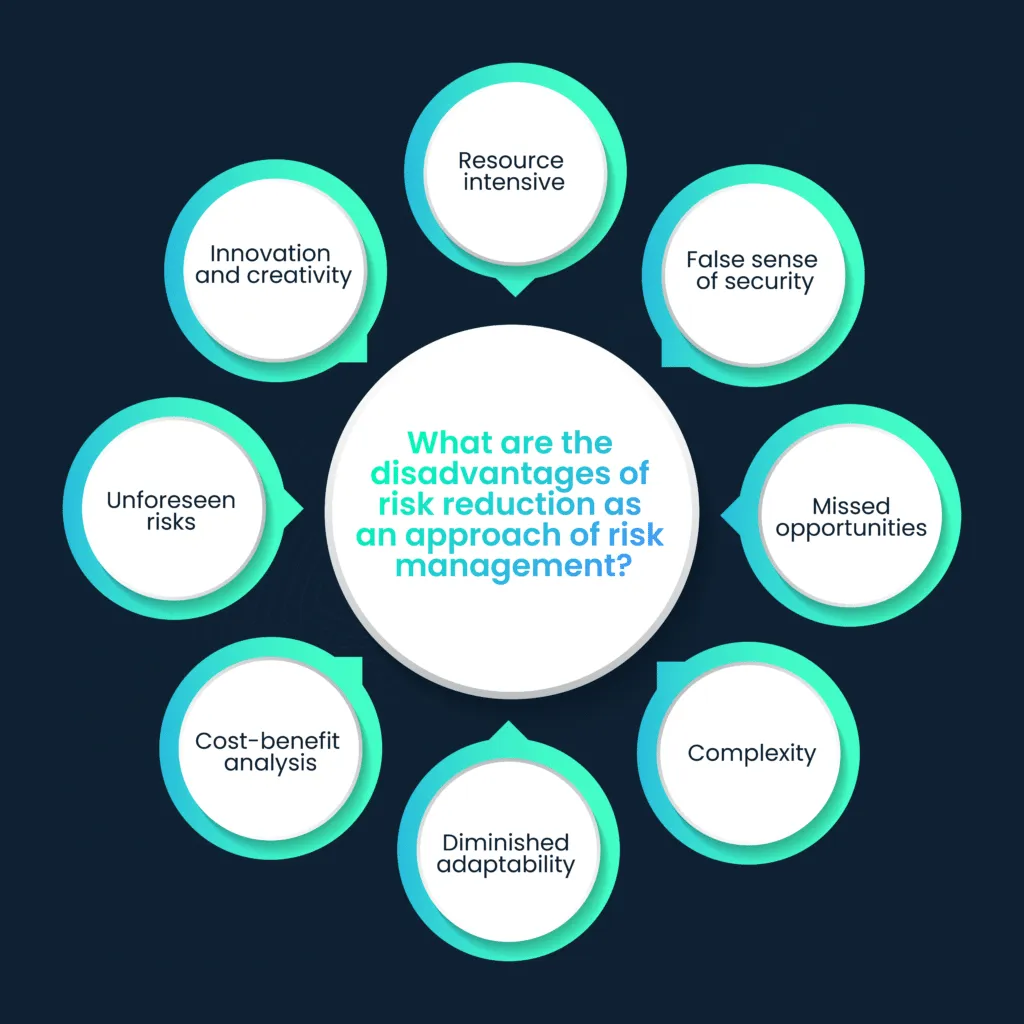
a. Resource intensive
Effective risk reduction measures can be resource intensive, requiring financial investments, time, and expertise. Smaller organizations may find it challenging to implement comprehensive risk reduction strategies.
b. False sense of security
Relying solely on risk reduction can lead to a false sense of security. While mitigation measures reduce risks, they may not eliminate them entirely, and unexpected events can still occur.
c. Missed opportunities
Overemphasis on risk reduction can lead to a conservative approach that avoids potentially rewarding opportunities. Organizations may be hesitant to take calculated risks for innovation or growth.
d. Complexity
Managing numerous risk reduction measures can become complex, requiring ongoing monitoring and adjustments. This complexity can strain resources and create bureaucratic processes.
e. Diminished adaptability
A strict focus on risk reduction may make an organization less adaptable to change or less capable of seizing new opportunities due to a reluctance to embrace risks.
f. Cost-benefit analysis
Determining the cost-effectiveness of risk reduction measures can be challenging. Deciding which measures to implement and how much to invest requires a thorough cost-benefit analysis.
g. Unforeseen risks
While risk reduction focuses on known risks, it may not account for unforeseen or emerging risks. This can leave organizations vulnerable to novel threats.
h. Innovation and creativity
In some cases, excessive risk reduction can stifle innovation and creativity. Organizations that are overly risk-averse may miss out on opportunities for disruptive innovation.
In summary, risk reduction offers significant benefits in terms of minimizing the impact of adverse events, enhancing decision-making, and ensuring compliance with regulations. However, it also has limitations, including resource-intensive requirements, a potential false sense of security, and the possibility of missed opportunities.
Effective risk management often involves striking a balance between risk reduction and other risk management strategies, considering the specific context and objectives of the individual or organization.
Factors to consider while choosing risk avoidance or risk reduction approaches

When choosing between risk avoidance and risk reduction approaches for managing a particular risk, several key factors should be considered. The decision should be based on a thorough assessment of these factors to determine the most appropriate strategy.
Here are the critical factors to take into account:
a. Severity of consequences
Consider the potential severity of the consequences if the risk were to materialize. If the consequences are catastrophic, involving significant harm, financial loss, or reputational damage, risk avoidance may be a more prudent choice.
b. Probability of occurrence
Assess the likelihood of the risk occurring. If the risk has a high probability of happening, it may be more practical to focus on risk reduction to minimize its impact.
c. Feasibility of avoidance
Evaluate whether it is feasible to avoid the risk entirely. Some risks may be impossible to eliminate due to industry requirements, legal obligations, or other factors.
d. Cost-benefit analysis
Conduct a cost-benefit analysis to determine if the resources and efforts required to avoid the risk outweigh the potential benefits. Consider the long-term implications of avoidance, including missed opportunities and potential costs.
e. Resource availability
Assess the availability of resources, including finances, personnel, technology, and expertise, for implementing risk reduction measures. Some risk reduction strategies may require significant investments.
f. Regulatory and legal requirements
Determine if there are regulatory or legal requirements that mandate specific risk management actions. Compliance with these standards may influence the choice of strategy.
g. Risk tolerance
Understand the risk tolerance of the individual or organization. Some entities may have a low-risk tolerance and prefer to avoid risks whenever possible, while others may be more willing to accept certain risks with appropriate mitigation measures in place.
h. Industry standards and best practices
Consider industry-specific standards and best practices for risk management. Adhering to these standards may guide the selection of risk reduction or avoidance strategies.
i. Competitive environment
Analyze the competitive landscape and the strategies employed by competitors. In highly competitive industries, risk management decisions can impact market positioning and competitiveness.
j. Long-term objectives
Align the choice of risk management strategy with long-term objectives and goals. Consider whether risk avoidance or risk reduction better supports the achievement of these objectives.
k. Opportunity cost
Assess the opportunity cost associated with risk avoidance. This involves evaluating the potential benefits and opportunities that may be missed by avoiding the risk.
l. Resilience and adaptability
Consider how the chosen strategy contributes to building resilience and adaptability. Resilience enables entities to recover from disruptions and adapt to changing circumstances.
m. Complexity and feasibility
Evaluate the complexity of implementing risk avoidance or risk reduction measures. Some strategies may be more straightforward to execute than others, affecting their feasibility.
n. Stakeholder expectations
Take into account the expectations and preferences of key stakeholders, including customers, investors, employees, and partners. Stakeholder trust and confidence can be influenced by risk management decisions.
o. Ethical considerations
Consider the ethical implications associated with the chosen strategy. Ethical concerns may influence the decision to avoid or reduce certain risks.
By systematically analyzing these factors and weighing the pros and cons of risk avoidance and risk reduction, individuals and organizations can make informed decisions that align with their specific circumstances, objectives, and risk tolerance. In some cases, a combination of both strategies may be the most effective approach to address complex risk scenarios.
Risk avoidance vs risk reduction: A comparative analysis
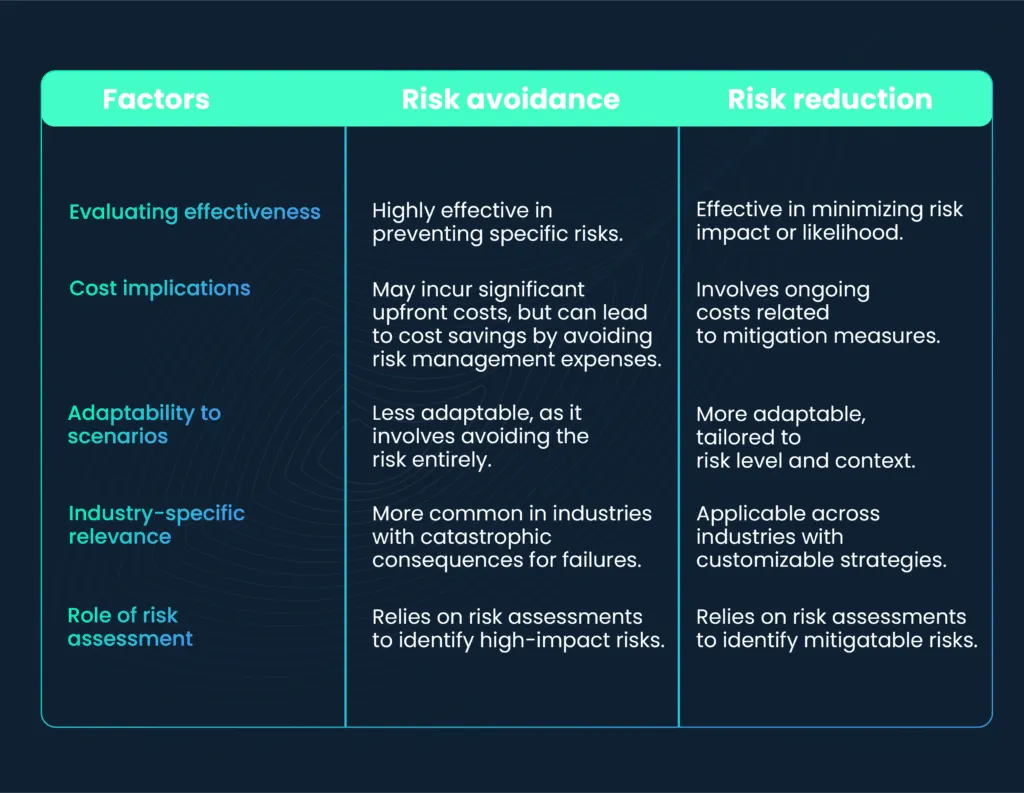
Striking a balance: The hybrid approach
The hybrid approach to risk management recognizes the potential synergy that can be achieved by combining risk avoidance and risk reduction strategies. While these two approaches have their distinct advantages and limitations, they can complement each other effectively in many situations. By recognizing the synergy between risk avoidance and risk reduction, organizations and individuals can create a more robust and comprehensive risk management framework.
This approach acknowledges that certain risks are best avoided, while others can be managed or mitigated to reduce their impact or likelihood. It allows for a balanced and nuanced response to risk, enhancing an entity’s ability to navigate uncertainties, seize opportunities, and safeguard against adverse events.
Final words
In conclusion, risk management involves two key approaches: risk avoidance and risk reduction.
Risk avoidance eliminates risks entirely, offering certainty and predictability but potentially missing out on opportunities. In contrast, risk reduction aims to minimize the impact and likelihood of risks, promoting adaptability and growth while demanding resources.
Choosing between these approaches requires considering factors like consequences, probability, feasibility, and resources. A hybrid approach that combines both strategies can provide a balanced response to risk, enhancing resilience and adaptability.
In the dynamic world of risk management, staying flexible and informed is essential for making informed decisions and achieving objectives in the face of uncertainty.
Ready to enhance your risk management strategy? Scrut is your solution! Explore the power of comprehensive risk analysis and decision-making. Get started today and safeguard your future!
FAQs
1. What is the primary difference between risk avoidance and risk reduction?
The main difference lies in their approaches to managing risks. Risk avoidance aims to completely eliminate risks by avoiding actions or situations that could lead to adverse consequences. Risk reduction, on the other hand, acknowledges the existence of risks but seeks to minimize their impact or likelihood through proactive measures.
2. When should I choose risk avoidance over risk reduction, and vice versa?
The choice depends on various factors, including the severity of consequences, probability of occurrence, feasibility of avoidance, cost-benefit analysis, resource availability, and long-term objectives. Risk avoidance is preferable when consequences are severe and unacceptable, while risk reduction is suitable for managing risks that can be mitigated without eliminating them entirely.
3. When is a hybrid approach to risk management recommended?
A hybrid approach, combining risk avoidance and risk reduction, is recommended when an entity faces a mix of risks. It allows for a balanced response, addressing catastrophic risks with avoidance and managing mitigate risks with reduction, thus enhancing resilience and adaptability.




